
Lion’s Mane, Hedgehog, Yamabushitake: A Multifaceted Mushroom
Share

The Lion’s Mane Mushroom (Hericium erinaceus), also known as the Hedgehog Mushroom, or by its Japanese name Yamabushitake, is a rather uniquely shaped fungus. Known from a vast endemic range across North America and Eurasia, the Lion’s Mane Mushroom has a long history with humans. Holding established places in Chinese, Japanese and North American mythologies, and centuries-old medicinal practices at least as far back as the Tang Dynasty in China. Lion’s Mane has been historically hailed for supporting the function of multiple organs, healing wounds, aiding digestion and stimulating Qi.
With such a long history of Lion’s Mane’s medicinal use, it is surprising how relatively limited modern research has been until recently; though new papers are now being published and more reliable studies are being conducted. Since the mid 1980’s there have been clinical trials and research exploring a wide range of possible benefits that may come from supplementation of Lion’s Mane Mushroom. Modern research begins with the initial clinical study in 1985 by Xu et al [1] studying the impact H. erinaceus might have on chronic atrophic gastritis; all the way to recent studies by Chen SK et al [2] exploring compounds extracted from Lion’s Mane to be used in hydrogels for wound healing.
Investigation has been expansive - with so many noted historical applications for the mushroom, researchers have numerous avenues of inquiry to explore. Papers have been published on a variety of matters, from enhancement of cognitive function and mood, nerve repair, improvements with memory, to neurotrophic and neuroprotective capabilities.
The value in such a wide range of studies is supported by the multifold bioactive compounds present in the fruiting body and mycelium of the Lions Mane Mushroom. These include numerous polysaccharides as well as secondary metabolites such as erinacines, hericerins, hericenones, resorcinols, steroids, mono- and diterpenes [3]. The availability of these compounds varies with hericenones being abundant in the fruiting body, while erinacines appear to be contained mainly in mycelia. Major polysaccharides present include alpha-glucans, beta-glucans, and glucan-protein complexes. The occurrence of these substances means medicinal properties of Lion's Mane may include antioxidant as well as antimicrobial effects [4].

Looking deeper into two particular studies we can see how some of the nutrients found in this complex mushroom may present applied real world benefits:
Work in the paper titled "Improvement of cognitive functions by oral intake of Hericium erinaceus" by Saitsu et al [5] took a group of 34 participants over the age of 50 to run randomized, double-blind, placebo-controlled trials to evaluate the improvement of their cognitive functions while taking supplements containing Lion’s Mane Mushroom fruiting body over 12 weeks. The trial compared results across three different forms of testing:
-
Mini Mental State Examination (MMSE); an oral test for the recognition functions including orientation, memory, calculation, language, and spatial abilities.
-
Benton visual retention test (BVRT); a practical test displaying abilities of visual recognition, memorization and reproduction of designs from memory.
- Standard verbal paired-associate learning test (S-PA); a test evaluating short-term memory by counting the correct answers after listening to and recalling 10 pairs of words.
Results varied across the three tests, with the total scores of the MMSE for the treatment group being significantly higher than the control group. The results of the BVRT and S-PA did not present any significant changes between treatment and control group to be of note over the duration of the trial.
The study finds that results of the “MMSE alone showed that oral intake of H. erinaceus significantly improved cognitive functions and prevented deterioration. We speculate that various chemical compounds, including hericenones, in the mushroom have multiple effects to the brain neural networks and improve cognitive functions”.
Another benefit of Lion’s Mane Mushroom supplementation appears to be of a neuroregenerative nature: “It is notable that not only did H.e prevent the deterioration of short-term memories, but also it improved the cognitive functions recorded in MMSE. It indicates the possibility that H.e helps regeneration of the neural networks in the adult brain.”[5] . It is speculated that the results could be caused by the benzaldehyde hericenones present in the mushroom with “hericenones activating synthesis of nerve growth factor (NGF) in the astrocytes, which is necessary for the survival of neural cells in the brain“[5].

The second study we will look at is titled “The Acute and Chronic Effects of Lion’s Mane Mushroom Supplementation on Cognitive Function, Stress and Mood in Young Adults: A Double-Blind, Parallel Groups, Pilot Study” by Docherty S et al [6].
The researchers began by examining 43 healthy adults between the ages of 18-45 using randomized, double-blind, placebo-controlled parallel-groups. The study investigated both the acute response and chronic exposure of Lion’s Mane effects on cognition and mood enhancement. This was conducted at a dosage of 1.8g of mushroom, which was taken orally for 28 days for chronic testing and recorded 60 minutes post-dose for the acute testing segment.
Cognitive function tests were delivered via the Computerised Mental Performance Assessment System (COMPASS), a program which allows participants to submit timed responses to visual and audio input across various pre-programed tests. The participants’ mood and psychological state were assessed with the following three systems:
-
Stress Visual Analogue Scales (S-VAS): Four scales rating levels of anxiety, stress, relaxation and calmness, combined to generate an average ‘stress’ score.
- Stress Visual Analogue Scales (VAMS): A scalar system to gauge responses on alertness, stress and tranquility.
- Perceived Stress Scale (PSS): Which measures the perception of stress through a scaled questionnaire, with participants self reporting on their feelings within the previous month.
During the testing of the Stroop Task (the famous experiment which demonstrates the difficulty in naming the colour of an ink blot when the name of the colour doesn’t match what the eye perceives), it was noted that “there was a significant treatment × timepoint interaction with regard to the speed of performance… with the participants performing significantly quicker following Lion’s Mane administration during the 1h post-dose assessment”.
In the chronic exposure phase of testing, a significantly lower score of baseline stress in the S-VAS score was noted for the Lion’s Mane group, yet no difference was observed for treatment groups in responses to the PSS. They report that the pilot trial “tentatively suggests that H. erinaceus may improve speed of performance and exert a stress-reduction effect”. [6]
It is theorised in this work that several bioactive compounds found in the Lion’s Mane Mushroom, such as hericenones and erinacines, can stimulate the expression of neurotrophic factors, including nerve growth factor synthesis and secretion, which may be crucial in producing mood-enhancing effects. Additionally, the anti-inflammatory effects of H. erinaceus may exert mood-enhancing effects by downward regulation of pro-inflammatory cytokine expression.
There is much to learn yet about the full range of Lion’s Mane Mushroom benefits. Trials to date are limited in terms of investigating single areas of brain function, as well as studies of singular compounds. More research is required to create a deeper and richer understanding into this ancient mushroom.
References:
1)Xu CP, Liu WW, Liu FX, et al. “A double-blind study of effectiveness of Hericium erinaceus pers therapy on chronic atrophic gastritis. A preliminary report.” Chin Med J (Engl). 1985;98(6):455-456.3932005
2)Chen SK, Liu JJ, Wang X, Luo H, He WW, Song XX, Nie SP, Yin JY. “Hericium erinaceus β-glucan/tannic acid hydrogels based on physical cross-linking and hydrogen bonding strategies for accelerating wound healing”. Int J Biol Macromol. 2024 Nov;279(Pt 4):135381. doi: 10.1016/j.ijbiomac.2024.135381. 6. PMID: 39244132.
3) Friedman M. et al. “Chemistry, Nutrition, and Health-Promoting Properties of Hericium erinaceus (Lion's Mane) Mushroom Fruiting Bodies and Mycelia and Their Bioactive Compounds.” J Agric Food Chem. 2015 Aug 19;63(32):7108-23. doi: 10.1021/acs.jafc.5b02914. Epub 2015 Aug 5. PMID: 26244378.
4) Khan, Md. Asaduzzaman, Tania, Mousumi, Liu, Rui and Rahman, Mohammad Mijanur. "Hericium erinaceus: an edible mushroom with medicinal values" Journal of Complementary and Integrative Medicine, vol. 10, no. 1, 2013, pp. 253-258. https://doi.org/10.1515/jcim-2013-0001
5) Saitsu Y, Nishide A, Kikushima K, Shimizu K, Ohnuki K. “Improvement of cognitive functions by oral intake of Hericium erinaceus." Biomed Res. 2019;40(4):125-131. doi: 10.2220/biomedres.40.125. PMID: 31413233 https://www.jstage.jst.go.jp/article/biomedres/40/4/40_125/_pdf/-char/en
6) Docherty S and Faye L. Doughty and Ellen F. Smith “The Acute and Chronic Effects of Lion’s Mane Mushroom Supplementation on Cognitive Function, Stress and Mood in Young Adults: A Double-Blind, Parallel Groups, Pilot Study” https://doi.org/10.3390/nu15224842
Disclaimer:
Mecatl Cacao makes no therapeutic use claims. Therapeutic is defined by the Australian Therapeutic Goods Administration (TGA) as:
1. preventing, diagnosing, curing or alleviating a disease, ailment, defect or injury in persons or animals; or
2. influencing, inhibiting or modifying a physiological process in persons or animals; or
3. testing the susceptibility of persons or animals to a disease or ailment; or
4. influencing, controlling or preventing conception in persons; or
5. testing for pregnancy in persons; or
6. the replacement or modification of parts of the anatomy in persons or animals.
As with any dietary supplement, it's always a good idea to speak with a trusted healthcare provider before adding it to your routine.

